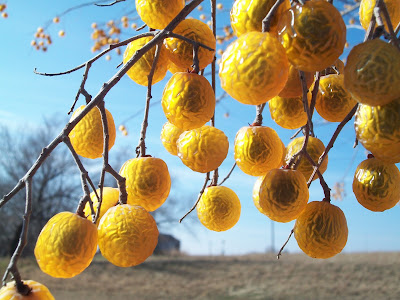When you look at the website http://www.sunshinenursery.com/ for SUNSHINE NURSERY Hwy 183 North of Clinton, Oklahoma, you will find a listing for Western Soapberry (Sapindus drummondii) under trees that are hardy in Western Oklahoma. Steve and Sherry Bieberich have spent a life time growing trees that thrive in this hot dry climate. If you are thinking about planting a tree this year, I recommend that you to go to SUNSHINE NURSERY and get one that will grow in the area you live. This Western Soapberry in our yard is beautiful all year. It has pretty blooms in the spring/summer and these yellow-orangeish berries appear in the fall and these sometimes stay all winter.
Soapberry is a single-stemmed, low-branched, round-crowned tree, growing 10-50 ft. tall, depending on habitat. Gray, sculpted bark is distinctive in the dormant season. Leaves up to 18 inches long with a central axis and as many as 24 paired leaflets. Flowers in large, cream colored clusters up to 10 inches long and 6 inches wide, appearing in May and early June. Fruit fleshy, globose, about 1/2 inch wide, flesh translucent, yellow turning darker with age, sometimes persistent on the tree until the next flowering season.
The poisonous fruit, containing the alkaloid saponin, has been used as a soap substitute for washing clothes. Necklaces and buttons are made from the round dark brown seeds, and baskets are made from the wood, which splits easily.
The variety name of this plant is named for Thomas Drummond, (ca. 1790-1835), naturalist, born in Scotland. In 1830 he made a trip to America to collect specimens from the western and southern United States. He collected 750 species of plants and 150 specimens of birds.
SUNSHINE NURSERY also has bedding plants, shrubs, landscape items, garden plants, and anything else you might want or need for your yard. The best part is the knowledge Steve and Sherry will share about what, when, where and how to pick out and plant stuff for your individual needs. Plus there are beautiful areas at the nursery, like the one below, that allows you to actually see what the various plants will look like together.





No comments:
Post a Comment